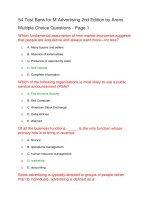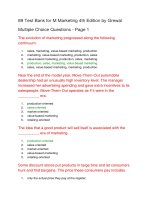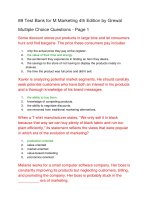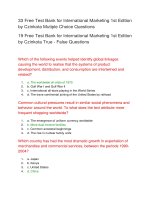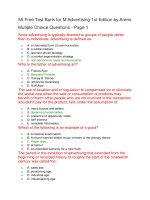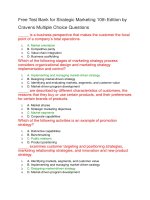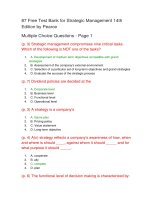Test bank for organic chemistry 1st edition by klein
Bạn đang xem bản rút gọn của tài liệu. Xem và tải ngay bản đầy đủ của tài liệu tại đây (459.46 KB, 39 trang )
Link full download: />
Test Bank for Organic Chemistry 1st Edition by Klein
Chapter 7
Topic: Introduction to Substitution
Section 1
Difficulty Level: Easy
1. Which of the following is a substitution reaction?
Ans: C
Chapter 7
Topic: Introduction to Substitution
Section 1
Difficulty Level: Easy
2. Which of the following is a substitution reaction?
Ans: D
Chapter 7
Topic: Introduction to Substitution
Section 1
Difficulty Level: Easy
3. Which of the following is a substitution reaction?
Ans: B
Topic: Introduction to Substitution
Section 1
Difficulty Level: Medium
5. Draw an example of a substitution reaction.
Ans: Numerous options!
Topic: Introduction to Substitution
Section 1
Difficulty Level: Easy
6. What is the nucleophile in the following reaction?
Ans: B
Topic: Introduction to Substitution
Section 1
Difficulty Level: Easy
7. What is the electrophile in the following reaction?
Ans: A
Topic: Introduction to Substitution
Section 1
Difficulty Level: Easy
8. What is the leaving group in the following reaction?
carbon
bromide
hydrogen
nitrogen
Ans: B
Topic: Introduction to Substitution
Section 1
Difficulty Level: Hard
9. What are two features typical of a leaving group?
Ans: 1. A leaving group withdraws electron density from the adjacent carbon, and
2. A leaving group can stabilize negative charge.
Topic: Introduction to Substitution
Section 1
Difficulty Level: Medium
10. For the following reaction, label the nucleophile, electrophile, and leaving group.
Ans:
Topic: Introduction to Substitution
Section 1
Difficulty Level: Easy
11. What is the nucleophile in the following reaction?
Ans: A
Topic: Introduction to Substitution
Section 1
Difficulty Level: Easy
12. What is the electrophile in the following reaction?
Ans: B
Topic: Introduction to Substitution
Section 1
Difficulty Level: Easy
13. What is the leaving group in the following reaction?
Sulfur
Carbon
Hydrogen
Iodide
Ans: D
Topic: Alkyl Halides
Section 2
Difficulty Level: Easy
14. Which of the following is the correct IUPAC name of the following structure?
Chlorocyclopentane
2-Chloro-1-methylcyclopentane
1-Methyl-2-chlorocyclopentane
1-Chloro-2-methylcyclopentane
Ans: D
Topic: Alkyl Halides
Section 2
Difficulty Level: Easy
15. Which of the following is the correct IUPAC name of the following structure?
3-Fluorobutane
2-Fluorobutane
(S)-2-Fluorobutane
(R)-2-Fluorobutane
Ans: C
Topic: Alkyl Halides
Section 2
Difficulty Level: Medium
16. Which of the following is the correct IUPAC name of the following structure?
2-Bromo-3-butylpentane
(2S)-Bromo-4,5-dimethylheptane
3,4-Dimethyl-6-bromoheptane
2-Bromo-4-methylhexane
Ans: B
Topic: Alkyl Halides
Section 2
Difficulty Level: Easy
17. Which of the following is the correct structure for a compound with the IUPAC
name of 2-bromo-3-methylbutane?
Ans: A
Topic: Alkyl Halides
Section 2
Difficulty Level: Easy
18. Which of the following is the correct structure for a compound with the IUPAC
name of 1-iodo-3-ethylcyclohexane?
Ans: B
Topic: Alkyl Halides
Section 2
Difficulty Level: Medium
19. Which of the following is the correct structure for a compound with the IUPAC
name of (2R)-2-fluorobutane?
Ans: D
Topic: Alkyl Halides
Section 2
Difficulty Level: Easy
20. Which of the following compounds has a tertiary carbon?
Ans: B
Topic: Alkyl Halides
Section 2
Difficulty Level: Easy
21. Provide an IUPAC name for the following compound.
Ans: 1,1-Dibromocyclopropane
Topic: Alkyl Halides
Section 2
Difficulty Level: Medium
22. Provide an IUPAC name for the following compound.
Ans: 2-Chloro-5-fluorohexane
Topic: Alkyl Halides
Section 2
Difficulty Level: Medium
23. On the following compound, label all of the primary, secondary, and tertiary
carbons.
Ans:
Topic: Alkyl Halides
Section 2
Difficulty Level: Medium
24. Identify the labeled carbon as primary, secondary, or tertiary.
Ans: tertiary
Topic: Alkyl Halides
Section 2
Difficulty Level: Easy
25. Identify the labeled carbon as primary, secondary, or tertiary.
Ans: primary
Topic: Alkyl Halides
Section 2
Difficulty Level: Easy
26. Identify the labeled carbon as primary, secondary, or tertiary.
Ans: secondary
Topic: Possible Mechanisms
Section 3
Difficulty Level: Medium
27. Provide a definition of a concerted reaction.
Ans: All bond breaking and making occurs at the same time.
Topic: Possible Mechanisms
Section 3
Difficulty Level: Easy
28. Which of the following is a reasonable definition of a concerted reaction?
It is a reaction which takes place in a series of steps.
It is a reaction which produces a loud noise.
It is a reaction in which all bond-breaking and bond-forming occurs at the same
time.
It is a substitution reaction.
Ans: C
Topic: Possible Mechanisms
Section 3
Difficulty Level: Hard
29. Provide examples of the 4 patterns for steps in the mechanisms of substitution
reactions.
Ans: 1. Nucleophilic attack, 2. Loss of a leaving group, 3. Proton transfer, and
4. Rearrangement
Topic: Possible Mechanisms
Section 3
Difficulty Level: Easy
30. Which of the following is not a possible step in a substitution reaction?
Ans: D
Topic: Possible Mechanisms
Section 3
Difficulty Level: Medium
31. Provide an arrow pushing mechanism for the following reaction.
Ans:
Topic: Possible Mechanisms
Section 3
Difficulty Level: Hard
32. Provide an arrow pushing mechanism and product for the following reaction.
Ans:
Topic: Possible Mechanisms
Section 3
Difficulty Level: Easy
33. When drawing an arrow-pushing mechanism, the tail of the arrow starts where?
At the bond that is being formed.
At the bond that is being broken.
At the source of electrons that is being moved.
At the location to which the electrons are being moved.
Ans: C or B
Topic: Possible Mechanisms
Section 3
Difficulty Level: Easy
34. When drawing an arrow-pushing mechanism, the head of the arrow goes where?
At the bond that is being formed.
At the bond that is being broken.
At the source of electrons that is being moved.
At the location to which the electrons are being moved.
Ans: D
Topic: Possible Mechanisms
Section 3
Difficulty Level: Easy
35. Which of the following shows the correct arrow for loss of a bromide leaving
group?
Ans: A
Topic: Possible Mechanisms
Section 3
Difficulty Level: Hard
36. Provide an arrow-pushing mechanism for the following (intramolecular)
reaction.
Ans:
Topic: SN2 Mechanism
Section 4
Difficulty Level: Easy
37. Which of the following is the rate law for the following SN2 reaction?
Rate = k[1-bromopropane]
Rate = k[NaCN]
Rate = k[NaCN][1-bromopropane]
Rate = k[NaCN]2
Ans: C
Topic: SN2 Mechanism
Section 4
Difficulty Level: Medium
38. Write the rate law for the following SN2 reaction.
Ans:
Topic: SN2 Mechanism
Section 4
Difficulty Level: Easy
39. Which of the following is the product of the following SN2 reaction?
Ans: C
Topic: SN2 Mechanism
Section 4
Difficulty Level: Hard
40. Which of the following is the product of the following SN2 reaction?
Ans: C
Topic: SN2 Mechanism
Section 4
Difficulty Level: Medium
41. Provide the SN2 product of the following reaction.
Ans:
Topic: SN2 Mechanism
Section 4
Difficulty Level: Medium
42. Provide a mechanism for this reaction.
Ans:
Topic: SN2 Mechanism
Section 4
Difficulty Level: Easy
43. Which of the following is a mechanism for an SN2 reaction?
Ans: C
Show arrows more carefully in B, C, D
Topic: SN2 Mechanism
Section 4
Difficulty Level: Easy
44. Which of the following is the product of the following reaction?
Ans: A
Topic: SN2 Mechanism
Section 4
Difficulty Level: Easy
45. Which of the following is the product of the following reaction?
Ans: D
Topic: SN2 Mechanism
Section 4
Difficulty Level: Easy
46. Which of the following is the product of the following reaction?
Ans: A
Topic: SN2 Mechanism
Section 4
Difficulty Level: Medium
47. What is the product of the following reaction?
Ans:
Topic: SN2 Mechanism
Section 4
Difficulty Level: Medium
48. What is the product of the following reaction?
Ans:
Topic: SN2 Mechanism
Section 4
Difficulty Level: Hard
49. From the given starting material, how could you stereospecifically form the
given product?
Ans:
Topic: SN2 Mechanism
Section 4
Difficulty Level: Easy
50. Rank the following substrates from most to least reactive in an SN2 reaction.
A>B>C>D
D>C>B>A
A>C>B>D
D>C>B>A
Ans: C
Topic: SN2 Mechanism
Section 4
Difficulty Level: Easy
51. Rank the following substrates from most to least reactive in an S N2 reaction.
A. A>B>C>D
B. D>C>B>A
C. C>B>A>D
D. D>C>B>A
Ans: C
Topic: SN2 Mechanism
Section 4
Difficulty Level: Easy
52. Rank the following substrates from most to least reactive in an S N2 reaction.
A. A>B>C>D
B. D>C>B>A
C. C>B>A>D
D. D>C>A>B
Ans: B
Topic: SN2 Mechanism
Section 4
Difficulty Level: Easy
53. Rank the following substrates from most to least reactive in an S N2 reaction.
A. A>B>C>D
B. C>D>B>A
C. C>B>A>D
D. D>C>B>A
Ans: B
Topic: SN2 Mechanism
Section 4
Difficulty Level: Hard
54. Draw a reaction diagram for the following reaction.
Ans:
Topic: SN2 Mechanism
Section 4
Difficulty Level: Medium
55. Which of the following is the reaction diagram for an exothermic, concerted
reaction?
Ans: C
Topic: SN2 Mechanism
Section 4
Difficulty Level: Easy
56. Given the following rate law, what will happen to the rate if the concentration of
MeI is doubled?
Rate = k[Me3N][MeI]
It will be doubled.
It will not change.
It will decrease in half.
It will increase very slightly.
Ans: A
Topic: SN2 Mechanism
Section 4
Difficulty Level: Easy
57. Given the following rate law, what will happen to the rate if the concentration of
both reactants is doubled?
Rate = k[Me3N][MeI]
A. It will be doubled.
B. It will not change.
C. It will decrease in half.
D. It will increase 4-fold.
Ans: D
Topic: SN2 Mechanism
Section 4
Difficulty Level: Easy
58. Given the following rate law, what will happen to the rate if the concentration of
MeI is doubled and the concentration of Me3N is halved?
Rate = k[Me3N][MeI]
A. It will be doubled.
B. It will not change.
C. It will decrease in half.
D. It will increase very slightly.
Ans: B
Topic: SN1 Mechanism
Section 5
Difficulty Level: Easy
59. Which of the following is the rate law for the following reaction?
Rate = k[H2O]
Rate = k[H2O][1-chloro-1-methylcyclohexane]
Rate = k[1-chloro-1-methylcyclohexane]
Rate = k[chloride ion]
Ans: C
Topic: SN1 Mechanism
Section 5
Difficulty Level: Medium
60. Provide the rate law for the following reaction.
Ans:
Topic: SN1 Mechanism
Section 5
Difficulty Level: Hard
61. Draw a reaction diagram for the following SN1 reaction.
Ans:
Topic: SN1 Mechanism
Section 5
Difficulty Level: Medium
62. Which of the following is a reaction diagram for an SN1 reaction that is
endothermic?
Ans: B
Topic: SN1 Mechanism
Section 5
Difficulty Level: Easy
63. Rank the following substrates from most to least reactive in an S N1 reaction.
A>B>C>D
A>B>D>C
D>A>B>C
D>C>B>A
Ans: A
Topic: SN1 Mechanism
Section 5
Difficulty Level: Easy
64. Rank the following substrates from most to least reactive in an S N1 reaction.
A. A>B>C>D
B. A>B>D>C
C. C>A>B>D
D. C>D>B>A
Ans: D
Topic: SN1 Mechanism
Section 5
Difficulty Level: Easy
65. Rank the following substrates from most to least reactive in an S N1 reaction.
A. A>B>C>D
B. A>B>D>C
C. D>A>B>C
D. D>C>B>A
Ans: A
Topic: SN1 Mechanism
Section 5
Difficulty Level: Easy
66. Rank the following substrates from most to least reactive in an S N1 reaction.
A. A>B>C>D
B. A>B>D>C
C. C>B>A>D
D. D>A>B>C
Ans: C
Topic: SN1 Mechanism
Section 5
Difficulty Level: Hard
67. Why is a tertiary alkyl halide more reactive in an SN1 reaction than a secondary
alkyl halide?
Ans: The tertiary cation is more stable.
Topic: SN1 Mechanism
Section 5
Difficulty Level: Hard
68. Provide a mechanism for the following SN1 reaction.
Ans:
Topic: SN1 Mechanism
Section 5
Difficulty Level: Easy
69. Which of the following is the product of the following reaction?
Ans: D
Topic: SN1 Mechanism
Section 5
Difficulty Level: Easy
70. Which of the following is the product of the following reaction?
Ans: B
Topic: SN1 Mechanism
Section 5
Difficulty Level: Easy
71. Which of the following is the product of the following reaction?
Ans: C
Topic: SN1 Mechanism
Section 5
Difficulty Level: Easy
72. Which of the following is the product of the following reaction?
Ans: A
Topic: SN1 Mechanism
Section 5
Difficulty Level: Medium
73. Provide the product of the following reaction.
Ans:
Topic: SN1 Mechanism
Section 5
Difficulty Level: Medium
74. What is the product of the following reaction. Include stereochemistry.
Ans:
Topic: SN1 Mechanism
Section 5
Difficulty Level: Easy
75. What is the product of the following reaction. Include stereochemistry.
Ans: A
Topic: SN1 Mechanism
Section 5
Difficulty Level: Hard
76. Why does a racemate form at the leaving group carbon in an SN1 reaction?
Ans: Because the cationic intermediate is planar and there is equal likelihood of
attack of the nucleophile from either face, leading to equal formation of both
enantiomers.
Topic: Drawing the Complete SN1 Mechanism
Section 6
Difficulty Level: Easy
77. Which of the following is a good leaving group?
-OH
-CH3
-Br
-NH2
Ans: C
Topic: Drawing the Complete SN1 Mechanism
Section 6
Difficulty Level: Medium
78. What is the best leaving group in the following compound?
Ans:
Topic: Drawing the Complete SN1 Mechanism
Section 6
Difficulty Level: Medium
79. Circle the best leaving group in the following compound.
Ans:
Topic: Drawing the Complete SN1 Mechanism
Section 6
Difficulty Level: Easy
80. Which of the following must be protonated in order to be a good leaving group?
Cl
Br
NMe2
OH2
Ans: C
Topic: Drawing the Complete SN1 Mechanism
Section 6
Difficulty Level: Easy
81. Which of the following nucleophiles will require a proton transfer step at the
end of the reaction?
NMe3
I–
OH–
H2S
Ans: D
Topic: Drawing the Complete SN1 Mechanism
Section 6
Difficulty Level: Medium
82. Provide an example of a nucleophile that will require a proton transfer step at
the end of the reaction.
Ans: Any protic nucleophile (so there are many answers).
Topic: Drawing the Complete SN1 Mechanism
Section 6
Difficulty Level: Easy
83. Which of the following alkyl halides would likely undergo rearrangement during
an SN1 reaction?
Ans: B
Topic: Drawing the Complete SN1 Mechanism
Section 6
Difficulty Level: Easy
84. Which of the following is the major product for the following S N1 reaction?
Ans: B
Topic: Drawing the Complete SN1 Mechanism
Section 6
Difficulty Level: Medium
85. Draw the anticipated major product for the following reaction.
Ans:
Topic: Drawing the Complete SN1 Mechanism
Section 6
Difficulty Level: Hard
86. Draw an energy diagram for the following reaction.
Ans:
Topic: Drawing the Complete SN1 Mechanism
Section 6
Difficulty Level: Hard
87. Draw a mechanism for the following reaction.
Ans:
Topic: Drawing the Complete SN1 Mechanism
Section 6
Difficulty Level: Hard
88. What is the anticipated major product for the following reaction?
Ans:
Topic: Drawing the Complete SN1 Mechanism
Section 6
Difficulty Level: Hard
89. What is the mechanism for the following reaction?
Ans:
Topic: Drawing the Complete SN1 Mechanism
Section 6
Difficulty Level: Medium
90. What is the rate law for the following SN1 reaction?
Ans:
Topic: Drawing the Complete SN2 Mechanism
Section 7
Difficulty Level: Easy
91. For the following reaction, which of the following is the mechanism?
SN1
SN2
Protonation
Elimination
Ans: B
Topic: Drawing the Complete SN2 Mechanism
Section 7
Difficulty Level: Easy
92. For the following reaction, which of the following is the product?
Ans: D
Topic: Drawing the Complete SN2 Mechanism
Section 7
Difficulty Level: Easy
93. For the following reaction, which of the following is the rate law?
k[HBr]
k[1-pentanol]
k[HBr][1-pentanol]
k[HBr]2
Ans: C
Topic: Drawing the Complete SN2 Mechanism
Section 7
Difficulty Level: Medium
94. Draw an energy diagram for the following reaction.
Ans:
